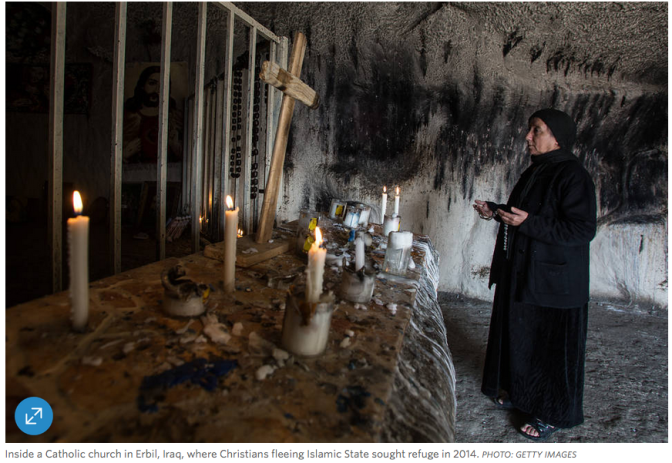In 1975, as desperate Vietnamese sought to escape Communist rule, the U.S. embarked on what remains one of the greatest humanitarian rescue missions in history. Over the span of several weeks, Operation Frequent Wind, Operation Babylift and other missions by air or on sea saved and resettled tens of thousands of Vietnamese in the U.S., where they would become thriving American citizens.
Now another desperate population needs rescuing: persecuted Christians in the Middle East. Could there be an Operation Frequent Wind for them?
Mark Arabo thinks so. He is a Chaldean-American and the founder of the Minority Humanitarian Foundation, a nonprofit organization whose mission is to get Iraqi Christians out before it’s too late. “There is historical precedent for this,” he says from his base in San Diego. “President Ford airlifted thousands during the Vietnam War and we need to do the same.”
An operation of this size would require extensive logistical planning, but Benjamin Weinthal, a research fellow for the Foundation for Defense of Democracies, says Operation Frequent Wind is repeatable. “Incirlik, the U.S. air base near Adana in Turkey, is close to the Syrian-Turkey border,” he says, suggesting that U.S.-led special-operation teams could stage a mission in partnership with European countries. “There are service personnel and planes to accomplish a rescue operation for persecuted Christians.”
Since the rise of Islamic State, known as ISIS, about 125,000 Christians have fled the country. After ISIS took Mosul in June 2014, the city’s Christians flocked to Erbil, the Kurdish capital. In Syria, once home to nearly two million Christians, at least 500,000 have been displaced during four years of war. It is ISIS policy to kidnap and rape Christian women and girls. The terrorist group has razed Christian sites, including monasteries dating to the fifth century. Last October the ISIS magazine Dabiq referred to Christians as “crusaders” and vowed to kill “every Crusader possible.”
That should remind Western policy makers: Christians are not random victims, caught in the maw of Mideast strife. They are targets of genocide, much like the Jews during World War II. This entitles them to broad protection under the 1951 U.N. Genocide Convention, to which the U.S. is a signatory.
It is also worth noting that because Christians in Iraq and Syria are facing genocide—as opposed to displacement—there is a limited window for rescue. Unlike the thousands of refugees pouring into Europe, who are mostly escaping the violence driven by the sectarian war in Syria, Christians are facing a targeted campaign of annihilation. The U.S. ought to take that distinction into consideration when prioritizing the resettlement of the additional 30,000 refugees the country is slated to absorb over the next two years.
Earlier this year, Rep. Juan Vargas, a California Democrat, introduced House Resolution 1568, the “Protecting Religious Minorities Persecuted by ISIS Act of 2015.” The act’s modest goal is to require the secretary of state to “report to Congress a plan to expedite the processing of refugee admissions applications” for religious minorities threatened with extinction by ISIS.
The bill hasn’t moved in Congress, partly due to inattention but also because the Obama administration seems to want nothing to do with it. “I haven’t heard anything from the administration on moving this bill forward,” says Illinois Republican Randy Hultgren, one of the bill’s co-sponsors. Mr. Arabo says the lack of movement illustrates “bureaucratic negligence and indifference” on the part of the administration. “The State Department has already indicated their unwillingness to reinstate processing for religious minorities.”
Meanwhile, Mr. Arabo is essentially running an underground railroad to help Christians escape. “We are bringing them to America, Australia and France,” he said. “In the U.S. alone, we have identified 70,000 Christians who have been displaced and have matched them with 70,000 people willing to bring them in.” But that depends on the administration’s willingness to allow them to enter.
In January 1944, two years after the Nazis settled on the “Final Solution” at the Wannsee conference, Franklin D. Roosevelt established a War Refugee Board “to forestall the plan of the Nazis to exterminate all the Jews and other persecuted minorities of Europe.” Though the board helped rescue some 200,000 people, it arrived too late—by this time, more than a million Jews had perished in Auschwitz. With another religious minority facing a similarly grim fate, Congress and the administration don’t have another moment to waste.
Source: Chloe Valdary, http://www.wsj.com
 Listen Online
Listen Online Watch Online
Watch Online Find a Station in Your Area
Find a Station in Your Area









 Listen Now
Listen Now Watch Online
Watch Online
